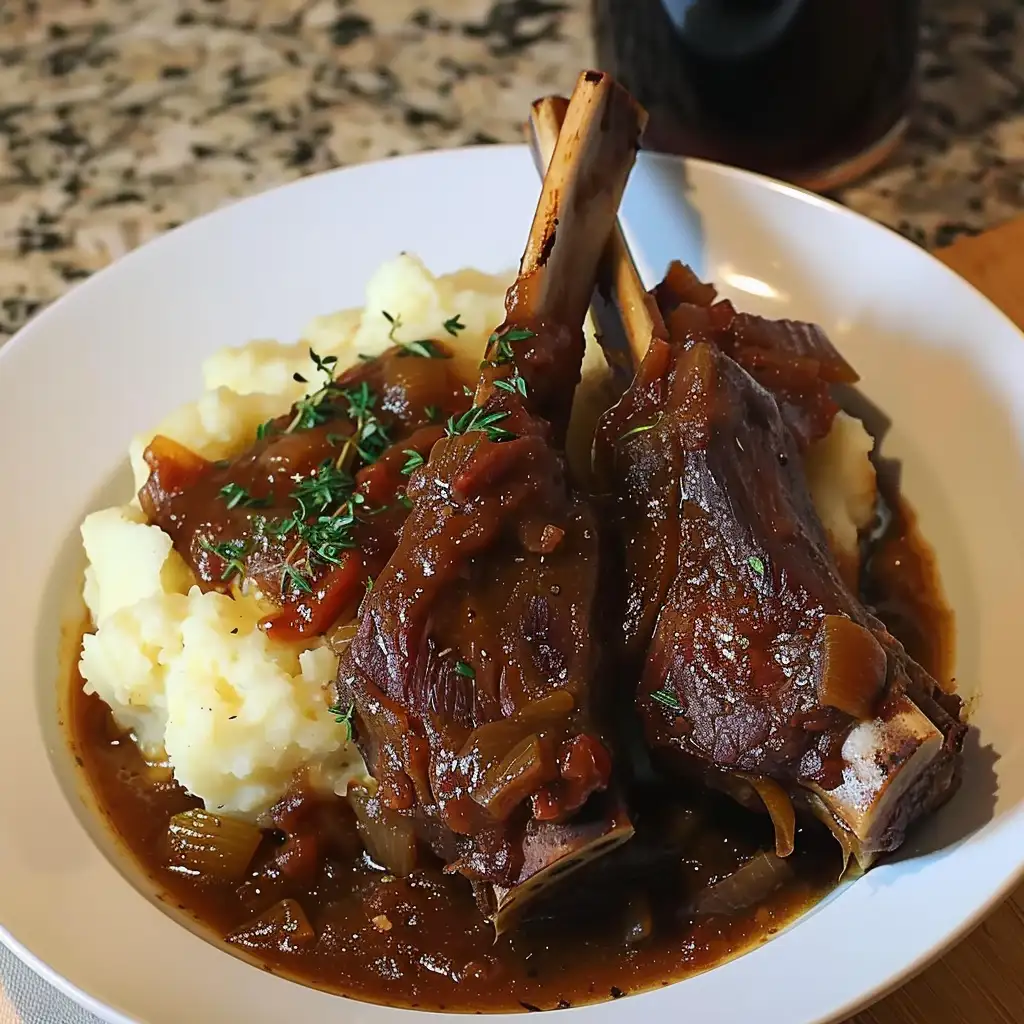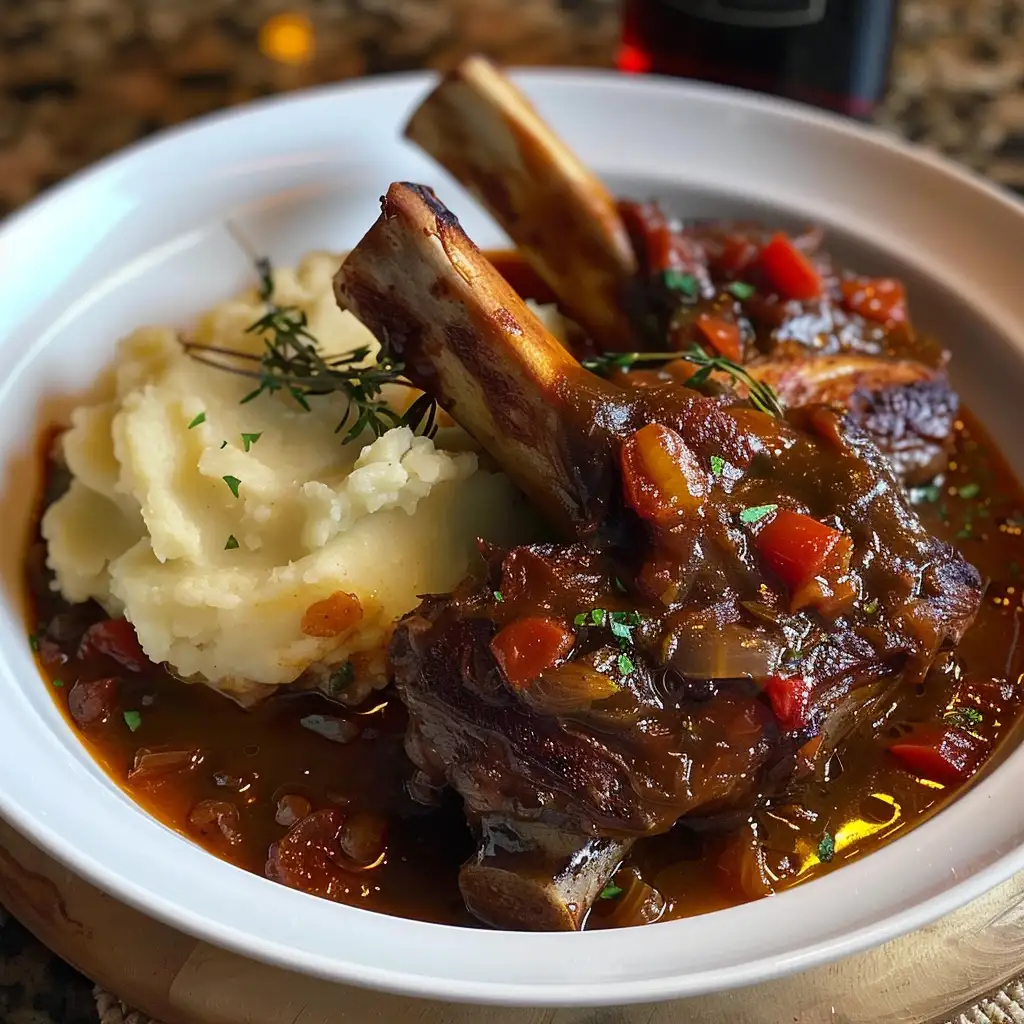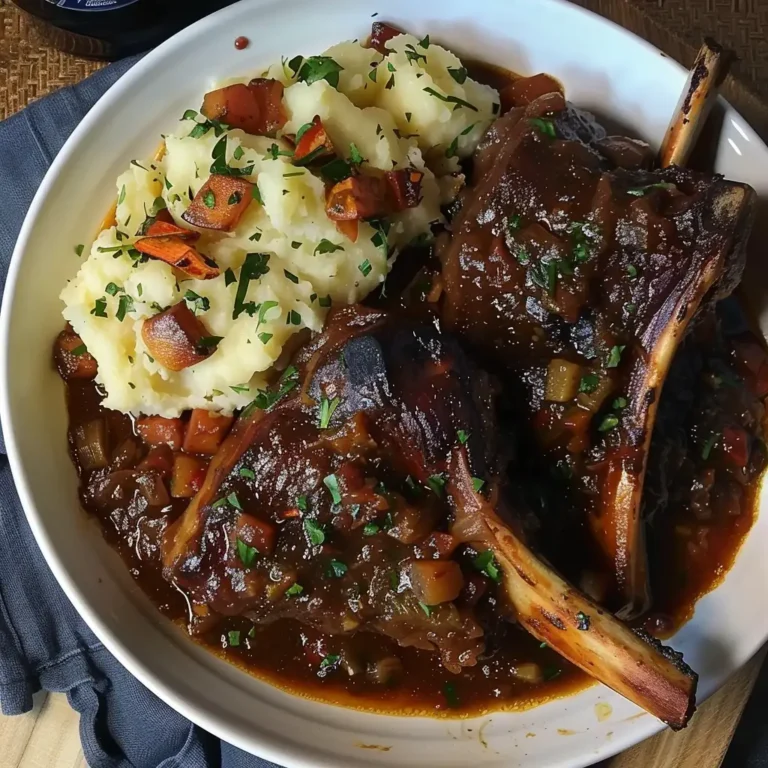Introduction to Stout-Braised Lamb Shanks
Stout-braised lamb shanks are a testament to the art of slow cooking, marrying robust flavors with tender, fall-off-the-bone meat. Originating from culinary traditions that emphasize hearty, comforting meals, this dish uses the dark, rich tones of stout to complement the savory depth of lamb. Historically, braising meats in beer or wine was not only a method to tenderize tougher cuts but also to infuse them with complex flavors. Today, stout-braised lamb shanks have gained popularity in both home kitchens and upscale restaurants, celebrated for their warmth and sophistication. The cooking method involves searing the lamb to a golden brown before slow-cooking it in a stout-infused broth, alongside a bouquet of vegetables and herbs, until it achieves perfect tenderness.
The Recipe Breakdown
Ingredients Overview
For a successful stout-braised lamb shank dish, the selection of ingredients is paramount:
- Lamb shanks: The star of the dish, known for their rich texture and flavor.
- Stout selection: A critical component that adds depth and complexity. Guinness or other dark stouts are preferred for their robust profiles.
- Vegetable and herb accompaniments include:
- Onions, garlic, and carrots for sweetness and aroma.
- Celery and rosemary for their herbal notes.
- Thyme and bay leaves, tied with kitchen twine, create a balanced bouquet garni.
Selecting the perfect stout is essential, as its flavor deeply influences the dish. Resources like Beer Advocate’s Stout Reviews offer comprehensive guides to choosing the right beer for cooking.
Preparation Steps
The process of making stout-braised lamb shanks involves careful preparation and slow cooking:
- Preparing the lamb shanks:
- Season the lamb with salt and pepper.
- Sear on all sides in a hot pan until browned, ensuring a rich flavor.
- Vegetable prep and aromatics:
- Saute onions and garlic until translucent.
- Add carrots and celery to the mix, cooking until softened.
- Combining ingredients and stout:
- Return the lamb to the pot with the prepared vegetables.
- Pour in the stout, adding enough to cover the meat and vegetables.
- Introduce a bouquet garni for an aromatic base.
The nutritional benefits of lamb, including its protein content and essential vitamins, make it an excellent choice for a wholesome meal. For detailed nutritional information, the Eatwell Guide is a valuable resource.
By meticulously following these steps and using quality ingredients, one can create a dish that is both a comfort food staple and a culinary delight.

Cooking Process
The journey to crafting the perfect stout-braised lamb shanks is one of patience and precision. Here’s how to bring this dish to life:
- Browning the lamb: This initial step is crucial for developing a deep flavor foundation. Season the lamb shanks generously with salt and pepper, then sear them in a hot pan with oil until each side is beautifully caramelized. This process not only enhances the taste but also locks in the juices.
- Simmering and braising: After browning, place the lamb back into the pot, and cover it with the stout and broth mixture. The key here is to simmer and braise the lamb at a low temperature for several hours. This slow cooking method allows the lamb to become tender, absorbing the rich, complex flavors of the stout and the aromatic bouquet of herbs and vegetables. During this time, the stout reduces, melding with the lamb’s juices and the vegetables to create a hearty, flavorful sauce. For an in-depth understanding of simmering and braising techniques, USDA’s cooking guides offer valuable insights.
- Final adjustments and sauce thickening: In the last half hour of cooking, adjust the seasoning with salt and pepper to taste. If the sauce is too thin, remove the lid to allow it to reduce further or thicken it with a flour or cornstarch slurry. The goal is a velvety sauce that perfectly coats the tender lamb.
Serving Suggestions
When it comes to serving stout-braised lamb shanks, presentation and accompaniments elevate the dish:
- Accompaniments and garnishes: Serve the lamb shanks on a bed of creamy mashed potatoes or a hearty root vegetable puree to complement the richness of the meat. A side of steamed green beans or sautéed spinach can add a fresh contrast to the dish.
- Presentation tips: Garnish with fresh chopped parsley or rosemary for a pop of color and a fragrant aroma. Spoon the reduced stout sauce over the lamb shanks, ensuring each piece is gloriously coated. Serving the dish in a deep plate or a shallow bowl showcases the beautiful braise, making it a feast for the eyes as well as the palate.
Crafting stout-braised lamb shanks is an art that rewards patience with profound flavors and comforting warmth. By following these steps, you can create a dish that resonates with tradition yet feels contemporary and refined.
Nutritional Information and Health Considerations
Health Benefits
Lamb is a nutrient-dense meat, rich in high-quality protein, essential vitamins (such as B12, niacin, and B6), and minerals like zinc and iron, which are crucial for muscle growth, immune function, and overall health. It also provides conjugated linoleic acid (CLA), known for its potential health benefits, including anti-inflammatory properties. However, it’s essential to consider the health considerations of stout, which, though providing a unique flavor, adds additional calories and carbohydrates to the dish. Moderation is key, and choosing a stout with lower alcohol content can reduce the overall calorie count. For comprehensive nutritional profiles, websites like the Eatwell Guide offer extensive databases.
Dietary Adjustments
For those with dietary restrictions or preferences, there are several substitutions:
- For a gluten-free version, select a gluten-free stout or replace stout with a gluten-free beer or beef broth.
- To reduce fat, opt for leaner cuts of lamb or consider alternative meats like beef shanks.

Advanced Cooking Techniques and Tips
Expert Tips for Perfect Braising
Braising is a technique that requires attention to detail and the right equipment:
- Choosing the right cookware: A heavy-bottomed Dutch oven is ideal for braising, as it distributes heat evenly and retains temperature well, essential for the long, slow cooking process.
- Managing cooking times and temperatures: Low and slow is the mantra for braising. Cooking at a gentle simmer allows the lamb to become tender without drying out. Monitoring the liquid level is crucial; add water or broth as needed to prevent the dish from drying.
Understanding the nuances of braising can be enhanced by exploring USDA’s cooking guides, which provide valuable insights into safe and effective cooking methods.
Variations of the Recipe
Experimenting with different stout beers can dramatically alter the dish’s flavor profile. A chocolate stout introduces a hint of sweetness, while a dry stout offers a more bitter note. Similarly, the choice of alternative meats and vegetables can transform the dish. Beef or pork shanks can be used in place of lamb for a different but equally satisfying result. Seasonal vegetables like parsnips or turnips can offer a new dimension of flavor and texture, making each iteration of the dish unique.
Incorporating these advanced techniques and variations into your cooking repertoire will not only enhance the stout-braised lamb shanks but also enrich your overall culinary skills, allowing for creativity and personalization in the kitchen.
Pairing and Wine Suggestions
Beverage Pairing
The robust flavors of stout-braised lamb shanks call for beverages that can complement and enhance the dish’s rich taste profile:
- Stout recommendations: Stick with the theme and pair the dish with a glass of the same stout used in cooking. This harmony of flavors enhances the meal’s cohesive taste experience.
- Wine pairings: Opt for full-bodied red wines that can stand up to the richness of the lamb. Varieties such as Shiraz, Cabernet Sauvignon, or Merlot offer the depth and complexity needed to complement the savory braised meat. A helpful resource for wine selection is Wine Enthusiast, which provides reviews and recommendations for all types of wines.
FAQs Based on “People Also Ask”
Common Questions and Answers
- Best types of stout for braising: The best stouts for braising are those with a deep, complex flavor profile, such as Irish dry stouts, imperial stouts, or oatmeal stouts. Each type brings a unique character to the dish, from the dry bitterness of an Irish stout to the sweet richness of an oatmeal stout.
- Making ahead and storing: Stout-braised lamb shanks are excellent for making ahead, as the flavors continue to develop when stored. Cool the dish quickly and refrigerate within two hours of cooking. Properly stored, it can last up to three days in the fridge or up to three months in the freezer. For safe storage tips, consult resources like the USDA’s Food Safety Guidelines.
- Tips for fall-off-the-bone meat: The key to tender, fall-off-the-bone meat is low and slow cooking. Maintain a gentle simmer and resist the temptation to rush the process. Braising for at least two to three hours on low heat allows the collagen in the lamb shanks to break down, resulting in tender meat. Additionally, ensuring the lamb is fully submerged in the cooking liquid promotes even cooking and moisture retention.
Incorporating these beverage pairings and addressing common questions can enhance the dining experience, making your stout-braised lamb shanks a memorable meal.


